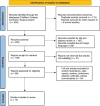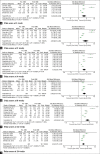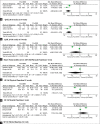Efficacy of splanchnic nerve neurolysis in the management of upper abdominal cancer pain: A systematic review and meta-analysis
- PMID: 38343676
- PMCID: PMC10858689
- DOI: 10.4103/ija.ija_439_23
Efficacy of splanchnic nerve neurolysis in the management of upper abdominal cancer pain: A systematic review and meta-analysis
Abstract
Background and aims: Neurolytic splanchnic nerve block (NSNB) is practised in intractable abdominal pain secondary to intra-abdominal malignancies. This review evaluated the efficacy of NSNB.
Methods: PubMed, Embase, Scopus, and Cochrane databases were searched for articles published from January 2001 to October 2023. Two independent reviewers extracted the data from the included studies. The quality of randomised controlled trials (RCTs) was assessed using the revised Cochrane risk-of-bias tool (RoB 2), and the Newcastle-Ottawa scale was used for cohort studies.
Results: Fourteen articles (4 RCTs, 3 non-randomised prospective, and 7 retrospectives) were included. Ten articles were quantitatively assessed and demonstrated significant pain relief at 1 week (standardised mean difference (SMD): 3.46 [2.09, 4.83], P < 0.001, I2 = 95%), 2 weeks (SMD: 4.45 [2.61, 6.29], P < 0.001, I2 = 95%), 4 weeks (SMD: 3.35 [2.23, 4.47], P < 0.001, I2 = 97%), 8 weeks (SMD: 3.7 [2.71, 4.7], P < 0.001, I2 = 86%), 12 weeks (SMD: 4.01 [2.66, 5.36], P < 0.001, I2 = 95%), and 24 weeks (SMD: 2.54 [1.71,3.37], P < 0.001, I2 = 84%). Daily narcotic consumption and quality of life (QOL) significantly improved post neurolysis, but survival rates showed controversial results. Significant heterogeneity was reported, and sub-group analysis revealed a moderate level of variability [I2 = 47.3%] pertaining to study design as a source of heterogeneity. The Grading of Recommendations, Assessment, Development and Evaluation (GRADE) Pro GDT recommendation for the primary objective was 'high' for the analysis of RCTs and 'very low' evidence quality for observational studies. Only transient minor complications were reported.
Conclusion: NSNB appears to be an efficacious technique that provides substantial pain relief, reduces opioid consumption, and ameliorates QOL.
Keywords: Abdominal pain; chemical neurolysis; chronic pain; intractable pain; neoplasms; neurolysis; opioid; quality of life; splanchnic nerve block; sympathetic.
Copyright: © 2023 Indian Journal of Anaesthesia.
Conflict of interest statement
There are no conflicts of interest.
Figures








Similar articles
-
Efficacy and Safety of Celiac Plexus Neurolysis Versus Splanchnic Nerve Neurolysis in the Management of Abdominal Cancer Pain: A Meta-analysis of 359 Patients.Pain Physician. 2024 Jan;27(1):1-10. Pain Physician. 2024. PMID: 38285023
-
Efficacy of cryoneurolysis in the management of chronic non-cancer pain: A systematic review and meta-analysis.Indian J Anaesth. 2022 Jul;66(7):485-497. doi: 10.4103/ija.ija_154_22. Epub 2022 Jul 22. Indian J Anaesth. 2022. PMID: 36111102 Free PMC article.
-
Fluoroscopy-guided Neurolytic Splanchnic Nerve Block for Intractable Pain from Upper Abdominal Malignancies in Patients with Distorted Celiac Axis Anatomy: An Effective Alternative to Celiac Plexus Neurolysis - A Retrospective Study.Indian J Palliat Care. 2017 Jul-Sep;23(3):274-281. doi: 10.4103/IJPC.IJPC_28_17. Indian J Palliat Care. 2017. PMID: 28827930 Free PMC article.
-
Efficacy and Safety of Neurolytic Splanchnic Nerve Block via Transintervertebral Disc Approach to Retrocrural Space: A Multicenter Retrospective Study.Pain Ther. 2022 Dec;11(4):1359-1372. doi: 10.1007/s40122-022-00432-7. Epub 2022 Sep 28. Pain Ther. 2022. PMID: 36169799 Free PMC article.
-
Effect of melatonin on quality of life and symptoms in patients with cancer: a systematic review and meta-analysis of randomised controlled trials.BMJ Open. 2022 Sep 14;12(9):e060912. doi: 10.1136/bmjopen-2022-060912. BMJ Open. 2022. PMID: 36104141 Free PMC article.
Cited by
-
Trial sequential analysis: Quality improvement for meta-analysis.Indian J Anaesth. 2024 Dec;68(12):1092-1094. doi: 10.4103/ija.ija_1051_24. Epub 2024 Dec 3. Indian J Anaesth. 2024. PMID: 39944024 Free PMC article. No abstract available.
-
Percutaneous Cryoneurolysis of Splanchnic Nerves for Pain Palliation in Patients with Pancreatic Cancer: A Single-Center Experience.Cardiovasc Intervent Radiol. 2025 Aug 5. doi: 10.1007/s00270-025-04142-3. Online ahead of print. Cardiovasc Intervent Radiol. 2025. PMID: 40764465
References
-
- Porta M, Fabregat X, Malats N, Guarner L, Carrato A, de Miguel A, et al. Exocrine pancreatic cancer: Symptoms at presentation and their relation to tumour site and stage. Clin Transl Oncol. 2005;7:189–97. - PubMed
-
- World Health Organization. 2nd. Geneva, Switzerland: WHO; 1996. 1996. Cancer Pain Relief.
-
- McNicol E. Opioid side effects and their treatment in patients with chronic cancer and noncancer pain. J Pain Palliat Care Pharmacother. 2008;22:270–81. - PubMed
-
- Caraceni A, Portenoy RK. Pain management in patients with pancreatic carcinoma. Cancer. 1996;78:639–53. - PubMed
-
- Firdousi FH, Sharma D, Raina VK. Palliation by coeliac plexus block for upper abdominal visceral cancer pain. Trop Doct. 2002;32:224–6. - PubMed
LinkOut - more resources
Full Text Sources
